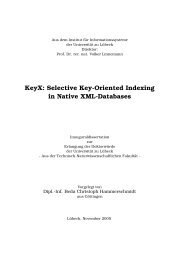Molecular characterisation of SGCE-associated myoclonus-dystonia ...
Molecular characterisation of SGCE-associated myoclonus-dystonia ...
Molecular characterisation of SGCE-associated myoclonus-dystonia ...
Create successful ePaper yourself
Turn your PDF publications into a flip-book with our unique Google optimized e-Paper software.
Results 54<br />
3.1.4 Qualitative mutational screening<br />
Six out <strong>of</strong> 35 (17.1%) index patients had either a point mutation (5 cases) or a small deletion<br />
(1 case) in the <strong>SGCE</strong> gene (four <strong>of</strong> these mutation-positive cases showed definite signs <strong>of</strong> M-<br />
D). One <strong>of</strong> the identified mutations was novel. This two base pair deletion in exon 6 induced a<br />
premature stop at codon 258 (c.771_772delAT, p.C258X).<br />
The remaining mutations had been previously described and are also predicted to prevent the<br />
synthesis <strong>of</strong> a full-length protein: Three index patients (IP1601, IP15251 and IP2625) carried<br />
disease-causing sequence changes in exon 3 (c.289C>T, p.R97X and twice c.304C>T;<br />
p.R102X). A one base pair substitution was detected in exon 6 (c.709C>T; p.R237X in<br />
IP15039). In the last patient (IP2141), a nonsense mutation in exon 9 (c.1114C>T, p.R372X)<br />
was found.<br />
3.1.5 Review <strong>of</strong> mutations in <strong>SGCE</strong><br />
Out <strong>of</strong> 51 publications, available on PubMed, 28 are reviewed here (see also 2.3.14). Taken<br />
together, 107 mutation-positive M-D cases have been described. For these patients, 64<br />
sequence changes in <strong>SGCE</strong> were identified, including 15 recurrent mutations (Fig 11). In 37%<br />
(40/107) <strong>of</strong> the above-mentioned individuals a single nucleotide change led to a truncation <strong>of</strong><br />
<strong>SGCE</strong>. With 33% (35/107), deletions were the second most frequent mutational cause <strong>of</strong> M-<br />
D. Among the 35 known deletions, ten are gene dosage alterations encompassing whole<br />
exons. Those account for 9% (10/107) <strong>of</strong> all cases with known mutations in <strong>SGCE</strong>. In<br />
addition to that, 12 (out <strong>of</strong> 107) patients with missense mutations (11%), 17 with splice site<br />
alterations (16%) and three individuals with insertions (3%) have been identified yet. The<br />
mutation detected with the highest frequency is a cytosine to thymine change at cDNA<br />
position 304 which leads to a premature stopcodon at AA position 102.

















